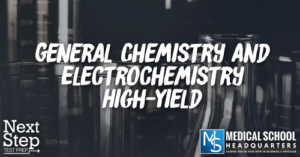You still have time to sign up with one of our amazing expert advisors! Learn More!

Today, we highlight some more high-yield stuff around General Chemistry and Electrochemistry. We’re joined once again by Clara from Blueprint MCAT (formerly Next Step Test Prep).
Whether you’re walking the dog or commuting to and from work, let us know how you’re listening to the podcast. Follow us on Instagram @medicalschoolhq and @nextstepmcat.
High-Yield Topic in General Chemistry: Electrochemistry
Electrochemistry is a challenge for many students because it isn’t always taught all that well in college classes. So you need to memorize things like oxidation potentials, reduction potentials, signs, etc.
There are actually patterns that make it easy to remember which is which. A lot of times, students think they seem to get it backwards and so they get intimidated by it. But once you have it down, it becomes the easiest thing!
[Related episode: Breaking Down an Organic Chemistry MCAT Passage]
Zn has an oxidation potential of +0.76, while Al has an oxidation potential of +1.66. Which metal serves as the better oxidizing agent?
(A) Al, because it more readily gives up electrons
(B) Zn, because it more readily gives up electrons
(C) Al3+, because it is more prone to gaining electrons
(D) Zn2+, because it is more prone to gaining electrons
Clara’s insights:
Oxidation refers to losing electrons. But with an oxidizing agent, it oxidizes something else so it reduces. So you have to recognize there’s an opposite thing happening here. Now, we’re looking for what metal to oxidize something else and which metal is best at reducing itself.
We’re looking at something that’s best at reducing itself to oxidize something else. The RIG part of OIL RIG is that reduction is gaining electrons.
Both answer choices C and D are both more prone to gaining electrons. The answer here is D. Al has its oxidation potential of +1.66. It had a higher oxidation potential because Zn is only 0.76. This means Al is better at oxidizing. But we’re looking at what’s better at reducing so that must be Zn, which is more prone to reducing.
The charges were placed there in answer choices C and D to probably only serve as a distraction. If you think about a half reaction, you might see something like Al becoming Al 3+ +3 electrons. One thing on one side of that reaction is always going to be charged.
Also, we’re looking for the thing that’s best at reducing itself. Al and Zn as metals can actually reduce themselves because to reduce, they have to gain electrons. And to gain electrons, they have to be negative.
But there’s no such thing as negative Al or negative Zn. So the only forms of Al and Zn that can actually reduce are the positive forms. Hence, the charges have been placed there only because it’s technically accurate with the charges.
Nickel-cadmium (NiCd) batteries are rechargeable cells used in products ranging from remote-control toys to airplanes. An NiCd battery in the process of discharging is most analogous to:
(A) a half-cell.
(B) an electrolytic cell.
(C) a galvanic cell.
(D) a nonspontaneous concentration cell.
Clara’s insights:
The correct answer here is C. It’s all about definitions here. The difference between electrolytic and galvanic is super close. It totally depends on whether they’re talking about a battery that’s discharging or recharging.
An electrolytic cell is one that’s nonspontaneous. It’s one where you’re putting a lot of power in to drive the reaction.
A galvanic cell is one that is spontaneous. It’s just running by itself because it is spontaneous and producing this electricity in a spontaneous fashion.
When a battery is discharging, it can build up all of this differential and spontaneously letting that energy go. A battery in a process of discharging is always going to be similar to a galvanic cell. An electrochemical cell is just like letting its spontaneous process go.
A half-cell is one half of an electrochemical cell. It’s not going to ever be a full battery. A full battery needs both halves. Any electrochemical cell would be made up of two parts. There’s a part that’s a cathode and another part that’s an anode. Half-cell is just one of those parts. It’s like a half-reaction.
A concentration cell is a type of galvanic cell that depends on different concentrations of the reactants involved. They’re always spontaneous. A nonspontaneous concentration cell is a trick because it doesn’t exist. A concentration cell is a thing. They’re MCAT relevant.
A certain electrochemical cell contains a positive (+) cathode. With this in mind, which of these statements is true?
(A) The cell is galvanic.
(B) The cell is electrolytic.
(C) This cell could be either electrolytic or galvanic; we cannot decide from this information alone.
(D) This cell is neither an electrolytic nor a galvanic cell.
Clara’s insights:
This question is relevant to other parts of the MCAT science as well. There are charges on electrodes. A cathode can be charged as well as an anode. The charge could be positive or negative.
It’s much easier to learn this if you could imagine what happens in an electrochemical cell in general. If ever you’ve heard the mnemonic RED CAT, AN OX. Reduction happens at the cathode and oxidation happens at the anode.
Now, if reduction happens at the cathode, that means electrons always go towards the cathode.
Reduction is the gain of electrons and electrons go towards the cathode.
If electrons are going towards the cathode and the cathode in this question is positive, it means that electrons are going in a spontaneous direction because electrons are negative.
Negative things love to go towards positive things. The question stem just confusingly describes a spontaneous reaction. Spontaneous means galvanic. So the cell must be galvanic because only the spontaneous cells are galvanic cells.
It becomes clear if it’s clicking when you can almost immediately eliminate some answer choices. In question packs, there’s a moment where you see it’s spontaneous in the process. Right away, you can get rid of two answer choices, which those that mention electrolytic cell.
Moreover, just be able to work through all those steps. There’s that moment when you’re going to be able to go through all the steps.
Before you even get into the electrochemical cell part of all of this, just learn about redox reactions. Understand things like positive oxidation potential or negative reduction potential. Then you already have what you need to do those steps. Just stay calm to do them.
If you’re looking for some more practice with the MCAT, @nextstepmcat does a free Question of the Day.
Blueprint MCAT (formerly Next Step Test Prep)
Follow us on Instagram @medicalschoolhq and @nextstepmcat.

Lorem ipsum dolor sit amet, consectetur adipiscing elit
I just received my admission to XXXXX! This is unreal and almost feels like I am dreaming. I want to thank you for all of your help with my application. I cannot overstate how influential your guidance and insight have been with this result and I am eternally grateful for your support!
IM SO HAPPY!!!! THANK YOU SO MUCH FOR ALL YOUR HELP, IM INDEBTED TO YOU! Truly, thank you so much for all your help. Thank you doesnt do enough.
I want to take a few moments and thank you for all of your very instructive, kind and consistent feedback and support through my applications and it is your wishes, feedback, and most importantly your blessings that have landed me the acceptance!
I got into XXXXX this morning!!!! It still has not hit me that I will be a doctor now!! Thank you for all your help, your words and motivation have brought me to this point.
I wanted to once again express my heartfelt gratitude for your help in providing feedback during my secondary applications. Your guidance has been instrumental in my journey.
Just wanted to share my wonderful news! I received my first medical school acceptance! Thank you for all that you do for us Application Academy!!!
I am excited to tell you that I just got my third interview invite from XXXXX today! I can’t believe it. I didn’t even know if I was good enough to get one, let alone three – by mid-September. Thank you so much for all of your help and support up to this point; I would not be in this position without it!!
I wanted to thank you for helping me prepare for my XXXXX interview. Even in a 30-minute advising session, I learned so much from you. Thank you for believing in me, and here’s to another potential success story from one of your advisees!
I just received an acceptance with XXXXX! This is so exciting and such a huge relief and so nice to have one of our top choice schools! I also received an interview with XXXXX which brings the total up to 20 interviews! Thank so much, none of this would have been possible without you!

Join our newsletter to stay up to date
* By subscribing you agree to with our Privacy Policy and provide consent to receive updates from our company.
Resources
Advising Services
Podcasts & Youtube
Books
About
Deal Lasts for

"*" indicates required fields